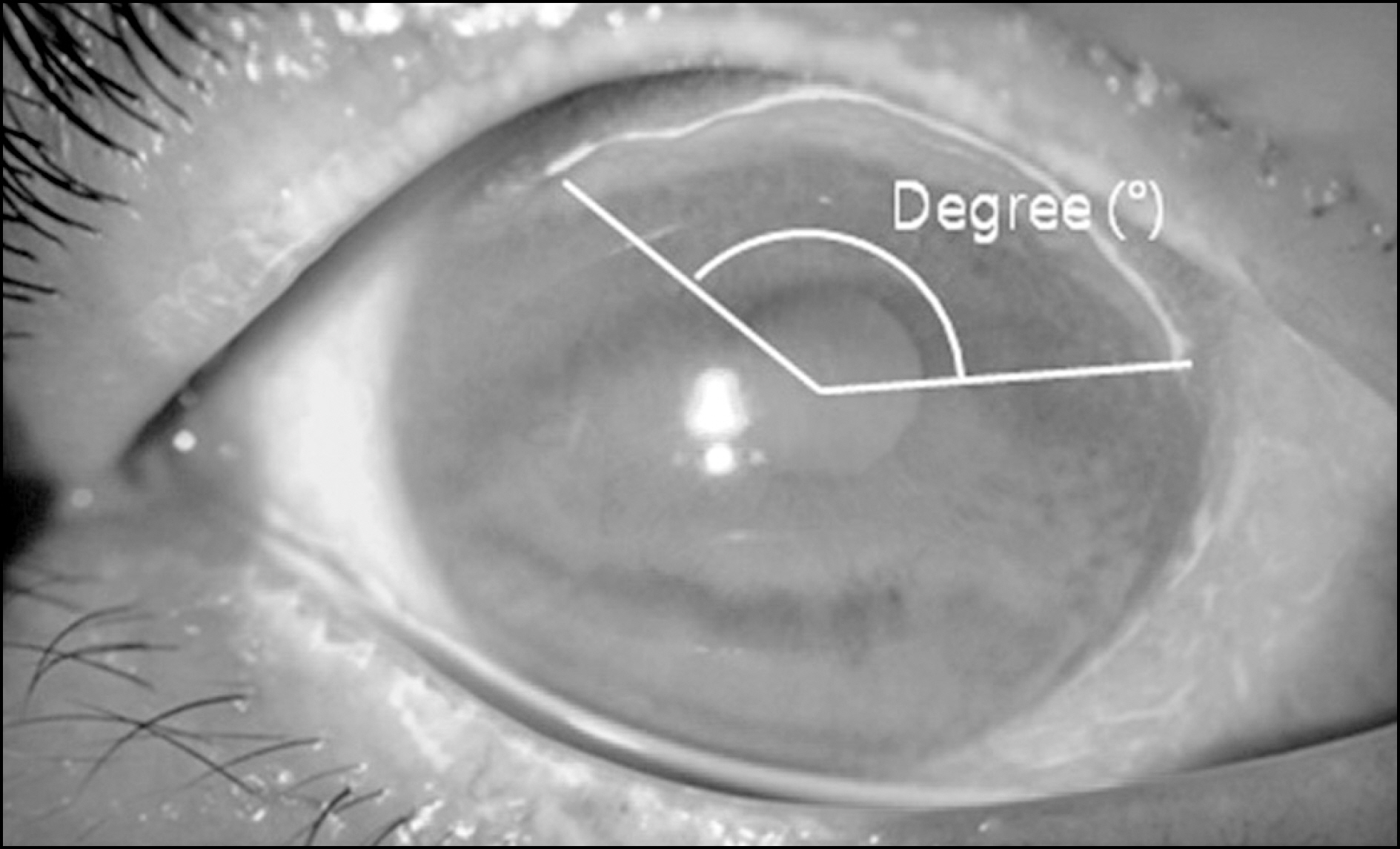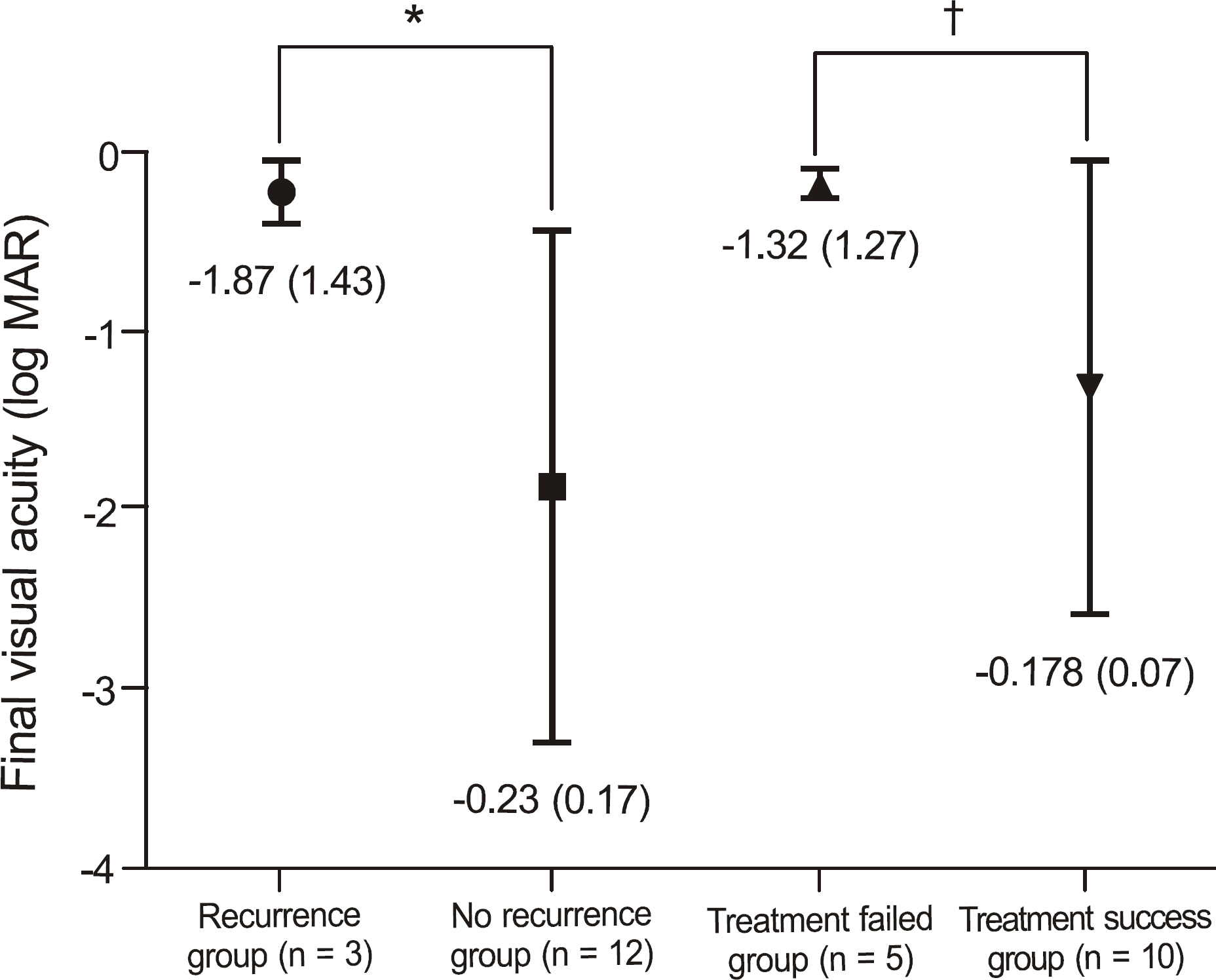J Korean Ophthalmol Soc.
2011 Aug;52(8):936-942. 10.3341/jkos.2011.52.8.936.
The Clinical Manifestations and Prognostic Factors of Autoimmune-Related Peripheral Corneal Ulcers
- Affiliations
-
- 1Department of Ophthalmology, Seoul National University College of Medicine, Seoul, Korea.
- 2Laboratory of Corneal Regenerative Medicine and Ocular Immunology, Seoul Artificial Eye Center, Seoul National University Hospital Clinical Research Institute, Seoul, Korea.
- KMID: 2214770
- DOI: http://doi.org/10.3341/jkos.2011.52.8.936
Abstract
- PURPOSE
To investigate clinical manifestations and prognostic factors of autoimmune-related peripheral corneal ulcers.
METHODS
Nineteen eyes in 18 patients who were diagnosed with autoimmune-related peripheral corneal ulcer from November 1999 to August 2010 were enrolled in the present study. Clinical manifestations and treatment results were investigated retrospectively.
RESULTS
The average age at presentation was 64.6 years with female (66.7%) and unilateral (94.4%) dominance. The main etiologies were Mooren's ulcer (53.6%) and rheumatoid arthritis (26.3%). The ulcer depth was greater than 75% of the corneal thickness in more than half of the cases (57.9%) and the mean extent of the ulcer was 69.5degrees. There were no significant improvements in visual acuity after treatment (p = 0.789) and no significant differences in treatment outcomes among etiologies or treatment modalities. The patients who underwent ulcer recurrence (p = 0.048) or treatment failure (p = 0.005) had poorer final visual acuity than those patients who did not. The ulcer depth correlated with treatment failure (p = 0.037). The final visual acuity showed positive correlations with visual acuity at presentation (p = 0.031) and negative correlations with the number of recurrences (p = 0.042).
CONCLUSIONS
The visual acuity at presentation and ulcer depths were significant prognostic factors. These factors appeared to be helpful in the treatment of marginal keratitis depending on the depth of the ulcer.
Keyword
MeSH Terms
Figure
Cited by 1 articles
-
A Case of Bilateral Peripheral Ulcerative Keratitis in a Patient with Rheumatoid Arthritis after Cataract Extraction
Jae Ho Jang, Youn Joo Ko, Seung Woo Lee
J Korean Ophthalmol Soc. 2013;54(5):808-812. doi: 10.3341/jkos.2013.54.5.808.
Reference
-
References
1. Mondino BJ. Inflammatory diseases of the peripheral cornea. Ophthalmology. 1988; 95:463–72.
Article2. Allansmith MR, McClellan BH. Immunoglobulins in the human cornea. Am J Ophthalmol. 1975; 80:123–32.
Article3. Lewallen S, Courtright P. Problems with current concepts of the epidemiology of Mooren's corneal ulcer. Ann Ophthalmol. 1990; 22:52–5.4. Chow CY, Foster CS. Mooren's ulcer. Int Ophthalmol Clin. 1996; 36:1–13.
Article5. Messmer EM, Foster CS. Vasculitic peripheral ulcerative keratitis. Surv Ophthalmol. 1999; 43:379–96.
Article6. Ladas JG, Mondino BJ. Systemic disorders associated with peripheral corneal ulceration. Curr Opin Ophthalmol. 2000; 11:468–71.
Article7. Malik R, Culinane AB, Tole DM, Cook SD. Rheumatoid keratol-ysis: a series of 40 eyes. Eur J Ophthalmol. 2006; 16:791–7.
Article8. Chen KH, Hsu WM, Liang CK. Relapsing Mooren's ulcer after amniotic membrane transplantation combined with conjunctival autografting. Ophthalmology. 2004; 111:792–5.9. Wood TO, Kaufman HE. Mooren's ulcer. Am J Ophthalmol. 1971; 71:417–22.
Article10. Chen J, Xie H, Wang Z, et al. Mooren's ulcer in China: a study of clinical characteristics and treatment. Br J Ophthalmol. 2000; 84:1244–9.
Article11. Woo SJ, Wee WR, Lee JH. The clinical manifestations of Mooren's ulcer. J Korean Ophthalmol Soc. 2002; 43:1388–96.12. Kim DG, Kim BJ. A peripheral corneal ulcer in rheumatoid arthritis. J Korean Ophthalmol Soc. 1987; 28:1083–7.13. Kervick GN, Pflugfelder SC, Haimovici R, et al. Paracentral rheumatoid corneal ulceration. Clinical features and cyclosporine therapy. Ophthalmology. 1992; 99:80–8.14. Bernauer W, Ficker LA, Watson PG, Dart JK. The management of corneal perforations associated with rheumatoid arthritis. An analysis of 32 eyes. Ophthalmology. 1995; 102:1325–37.15. Messmer EM, Foster CS. Destructive corneal and scleral disease associated with rheumatoid arthritis. Medical and surgical management. Cornea. 1995; 14:408–17.16. Tauber J, Sainz de la Maza M, Hoang-Xuan T, Foster CS. An analysis of therapeutic decision making regarding immunosuppressive chemotherapy for peripheral ulcerative keratitis. Cornea. 1990; 9:66–73.
Article17. Gottsch JD, Liu SH, Minkovitz JB, et al. Autoimmunity to a cornea-associated stromal antigen in patients with Mooren's ulcer. Invest Ophthalmol Vis Sc. 1995; 36:1541–7.18. Dana MR, Qian Y, Hamrah P. Twenty-five-year panorama of corneal immunology: emerging concepts in the immunopathogenesis of microbial keratitis, peripheral ulcerative keratitis, and corneal transplant rejection. Cornea. 2000; 19:625–43.19. Feder RS, Krachmer JH. Conjunctival resection for the treatment of the rheumatoid corneal ulceration. Ophthalmology. 1984; 91:111–5.
Article20. Fogle JA, Kenyon KR, Foster CS. Tissue adhesive arrests stromal melting in the human cornea. Am J Ophthalmol. 1980; 89:795–802.
Article21. Bessant DA, Dart JK. Lamellar keratoplasty in the management of inflammatory corneal ulceration and perforation. Eye. 1994; 8:22–8.
Article22. Raizman MB, Sainz de la Maza M, Foster CS. Tectonic keratoplastyaccommodative for peripheral ulcerative keratitis. Cornea. 1991; 10:312–6.
- Full Text Links
- Actions
-
Cited
- CITED
-
- Close
- Share
- Similar articles
-
- A Case of Peripheral Corneal Ulcer Treated with Partial Lamellar Keratoplasty
- Sterile Corneal Peripheral Perforation after Cataract Surgery in Terrien's Marginal Degeneration
- A Case of Peripheral Corneal Ulceration Associated with Autoimmune Hepatitis
- A supplemental treatment for the corneal ulcer or the other corneal diseases
- Three Cases of Pseudomonas Corneal Ulcer in Soft Contact Lens Wearer



